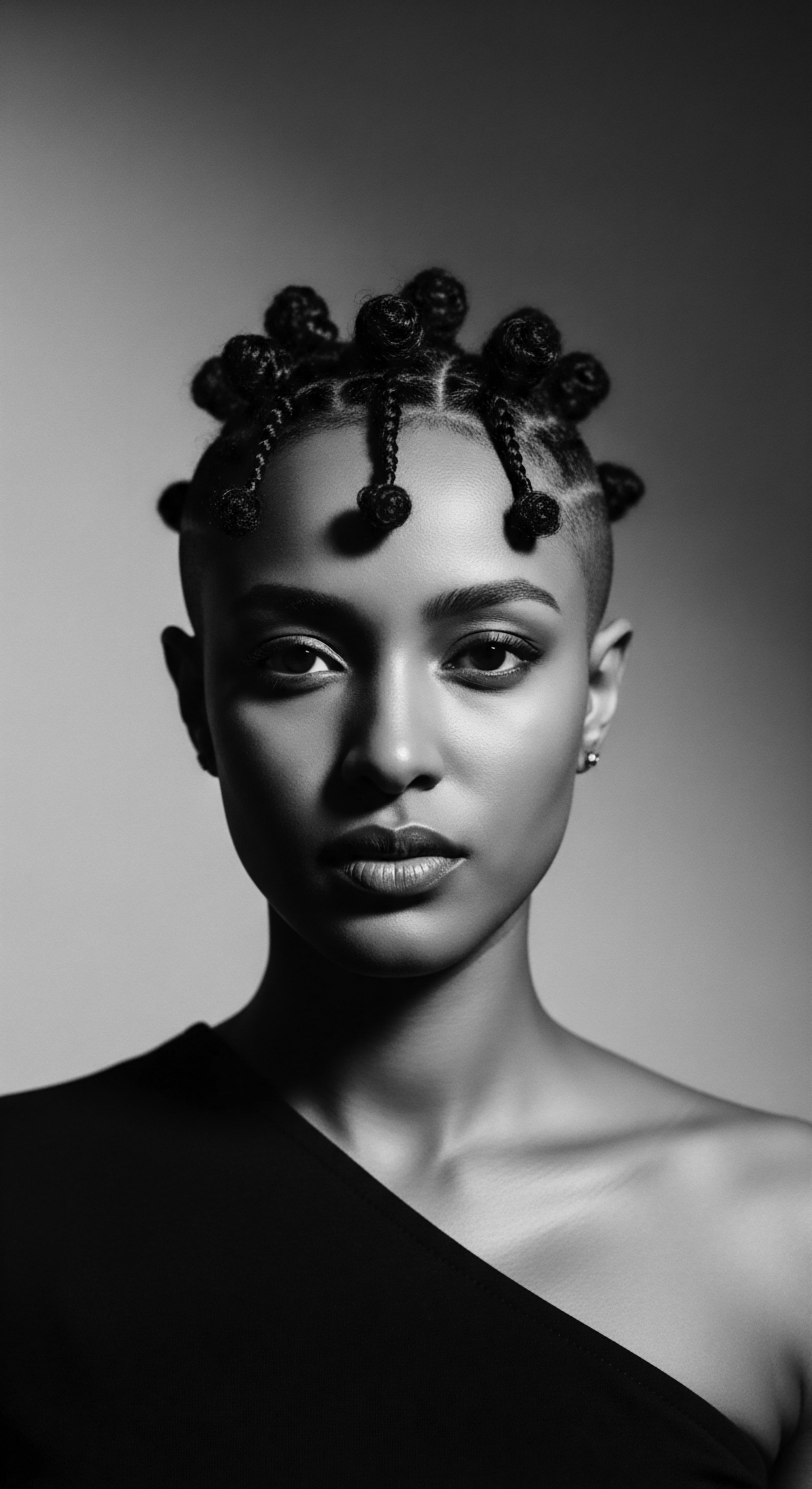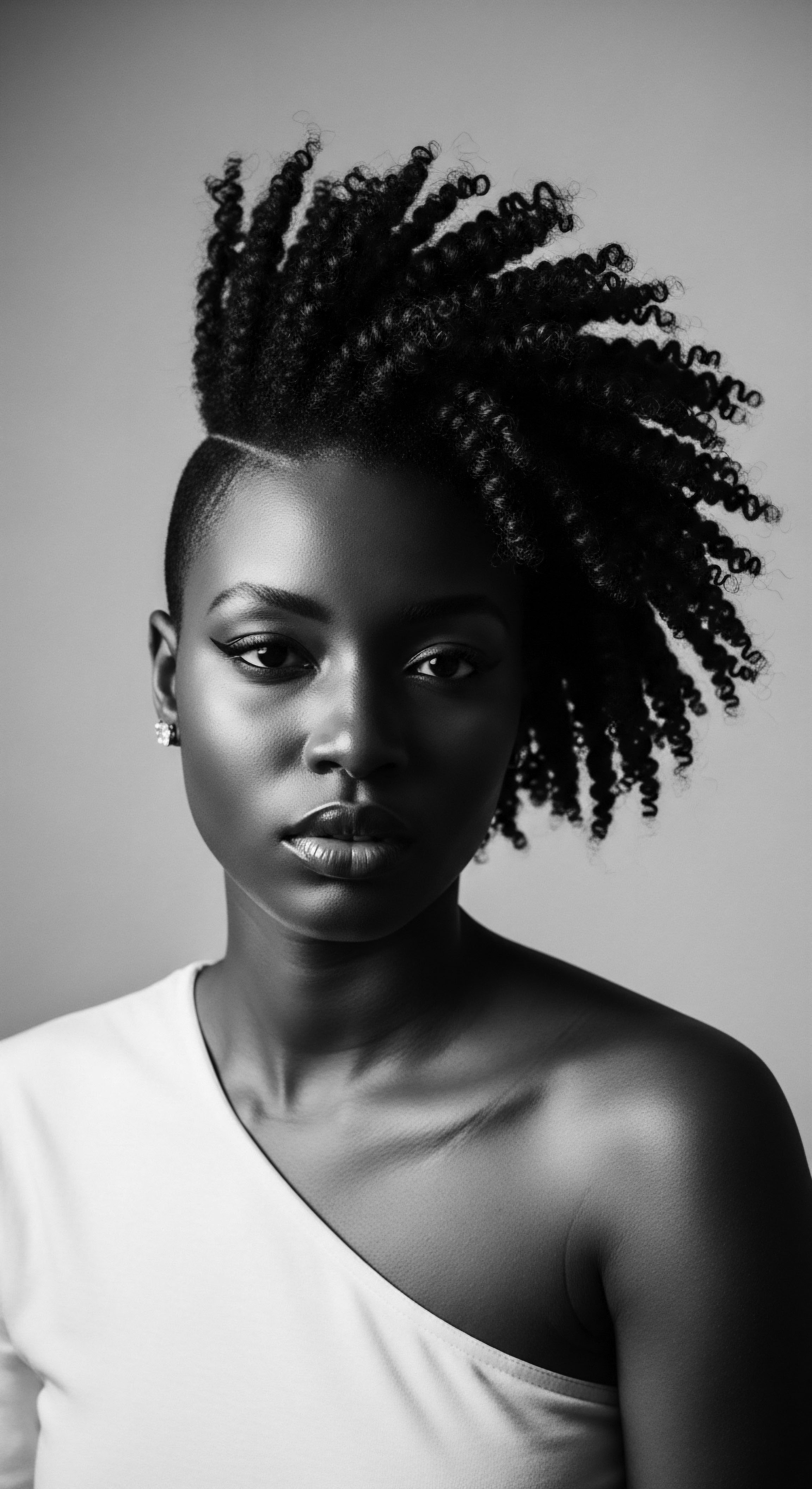
Fundamentals
Communal Strength, a concept both elemental and deeply resonant, speaks to the collective power woven into the fabric of textured hair heritage. It is the inherent capacity for resilience and sustained well-being that arises from shared practices, mutual support, and the exchange of wisdom within a community. Within the rich traditions of Black and mixed-race hair care, this strength manifests not as an abstract ideal, but as a tangible force, shaping individual identity and reinforcing societal bonds. The very essence of tending to textured hair, from ancient rituals to contemporary gatherings, has historically been a communal undertaking.
This shared experience of hair care moves beyond mere aesthetics; it nurtures the spirit, cultivates self-acceptance, and provides a framework for understanding one’s place within an enduring lineage. Communal Strength, therefore, is an elucidation of how collective effort in hair preservation and adornment serves as a wellspring of identity. It clarifies that beauty, for textured hair, is often a collaborative endeavor, a dialogue between generations and individuals, each strand a testament to a shared journey.
Understanding its meaning means recognizing the profound significance of shared spaces, like the historical and contemporary Black hair salon, which stand as vibrant community hubs. These are spaces where knowledge is exchanged, stories are shared, and bonds are forged through the therapeutic rhythm of hands working on hair. Historically, these establishments have served as critical sites for community building, dating back to the 1800s, where they facilitated information sharing and even addressed health disparities within African American communities.
The description of Communal Strength also touches upon the elemental practices that have defined textured hair care for centuries. These are practices born of necessity, adapted through resilience, and passed down as cherished wisdom.
Communal Strength within textured hair traditions is the enduring collective wisdom and mutual support that strengthens individual identity and perpetuates cultural heritage through shared care practices.
A primary aspect of this fundamental connection rests in the shared understanding of hair’s unique biological structure. Textured hair, with its diverse curl patterns, from gentle waves to tight coils, requires specific forms of care. The collective sharing of techniques, knowledge about natural ingredients, and protective styles has been instrumental in preserving hair health across generations. This foundational understanding allowed communities to adapt and innovate, ensuring the vitality of their strands in various climates and circumstances.
- Oral Traditions ❉ Knowledge passed down through generations, often during communal hair sessions, ensuring ancestral wisdom about hair care techniques and ingredients endured.
- Shared Resources ❉ Communities often pooled natural resources, like shea butter or specific plant oils, for collective hair nourishment and maintenance.
- Mutual Grooming ❉ The act of one individual styling another’s hair, a practice deeply rooted in many African cultures, fostering bonds and trust.
The designation of Communal Strength is a recognition of this collective enterprise—an acknowledgment that the strength of the individual strand is often tied to the strength of the collective hand that tends to it. It is an interpretation that moves beyond superficial appearances, delving into the deep roots of shared heritage and the enduring power of community in shaping how textured hair is perceived, cared for, and celebrated. This initial clarification illuminates the core idea that hair, for these communities, is rarely a solitary concern, but rather a profoundly collective one.

Intermediate
Stepping beyond the foundational tenets, the intermediate meaning of Communal Strength for textured hair experiences unfolds as a sophisticated exploration of its historical trajectory and its role in shaping cultural identity. This concept is not merely a description of social bonding; it encompasses the dynamic interplay between heritage, resistance, and self-affirmation, particularly within the African diaspora. It represents a deeper sense of continuity, a lineage of care and collective defiance against pressures to conform.

Echoes from the Source ❉ Hair as an Ancestral Ledger
In many ancient African societies, hair was a powerful communication system, far beyond a simple adornment. Hairstyles conveyed profound messages about a person’s age, marital status, social standing, religious beliefs, and even tribal affiliation. The intricacy and symbolism woven into each braid or coif represented a living ledger of one’s place within the community and their connection to the spiritual realm.
The act of tending to hair was often a sacred ritual, a communal activity that strengthened intergenerational bonds. Mothers, daughters, and friends gathered, weaving not only strands of hair but also stories, traditions, and collective identities.
When African people were forcibly brought across the Atlantic during the transatlantic slave trade, one of the first brutal acts of erasure was the shaving of their heads. This deliberate act aimed to strip individuals of their cultural identity, their connection to ancestry, and their sense of self. Even in the face of such dehumanization, Communal Strength persisted as enslaved individuals found ways to reclaim their hair and, by extension, their heritage.
Braids became a quiet, powerful act of resistance, sometimes even containing seeds for future harvests or maps to freedom. This defiant continuity underscores a deeper meaning of Communal Strength ❉ the capacity to maintain cultural practices and identity even under the most oppressive conditions.
Communal Strength is the enduring spirit of Black hair traditions, a heritage of collective care that has consistently resisted cultural erasure and affirmed identity across generations.
This communal preservation continued throughout the centuries. For example, during the period of American slavery, Sundays served as the only day of rest for enslaved people, a time when hair care became a communal tradition. Accounts like that of “Aunt Tildy” Collins illustrate mothers and grandmothers preparing hair together, using techniques such as threading or plaiting to create defined curls. Such instances, seemingly small, were vital acts of collective self-care and cultural preservation, solidifying communal bonds through shared vulnerability and mutual beautification.

The Tender Thread ❉ Salons as Sanctuaries of Shared Experience
The Black hair salon has long been a quintessential embodiment of Communal Strength in the African diaspora. These spaces transcend their commercial function, becoming vibrant community hubs where clients not only receive specialized care for their textured hair but also engage in social interaction, share experiences, and discuss local issues. They serve as informal forums where cultural knowledge is disseminated, where stories are told, and where mutual support forms a protective sphere against external biases.
| Historical Period Pre-colonial Africa |
| Setting for Communal Strength Family compounds, village gatherings |
| Historical Period Slavery Era (Americas) |
| Setting for Communal Strength Slave quarters, clandestine meetings |
| Historical Period Post-Emancipation (19th-20th C.) |
| Setting for Communal Strength Kitchens, beauty parlors, barbershops |
| Historical Period Modern Era (21st C.) |
| Setting for Communal Strength Salons, online hair communities, social media groups |
| Historical Period From ancient gatherings to digital platforms, communal spaces for hair care have persistently adapted, reflecting the unwavering collective spirit of textured hair communities. |
The significance of these spaces extends to economic empowerment. Black-owned hair salons have historically been avenues for entrepreneurship for African American women, offering economic opportunities when other avenues were limited. This economic independence, in turn, reinforced Communal Strength by providing services tailored to specific needs, reinvesting in local economies, and creating jobs within the community. It underscores the idea that supporting these spaces was, and remains, a form of communal solidarity, fostering not just physical beauty but also economic stability and self-determination.
The meaning of Communal Strength, from an intermediate standpoint, acknowledges the persistent struggle against Eurocentric beauty standards. The “Black is Beautiful” movement of the 1960s, followed by the modern natural hair movement of the late 2000s, exemplified how hair became a political statement and a symbol of resistance. These movements, fueled by social media, encouraged Black individuals to reject chemical alterations and embrace their natural kinks, curls, and coils.
The shared journey of “going natural” created new communities, both online and offline, where individuals found support, shared advice, and collectively challenged ingrained biases. This collective embrace of natural texture fortified Communal Strength, transforming personal hair choices into a powerful statement of cultural pride and self-acceptance.
The intermediate explanation of Communal Strength, therefore, is rooted in this ongoing dialogue between past and present, tradition and transformation. It highlights how the acts of caring for, styling, and celebrating textured hair are deeply intertwined with the broader history of Black and mixed-race communities, serving as a continuous testament to collective identity, survival, and affirmation. The understanding is not static; it lives and breathes through the narratives of those who carry these traditions forward.

Academic
From an academic perspective, Communal Strength represents a complex psychosocial construct, rigorously grounded in the intersection of cultural anthropology, neurobiology, and the sociology of identity. It delineates the profound, multifaceted power that emerges from the shared practices and collective affirmation within communities centered around textured hair. This concept is not merely anecdotal; it describes a deeply ingrained, historically evidenced phenomenon with measurable social, psychological, and even physiological implications.
It is a nuanced understanding of how individuals, through communal engagement with hair care, reinforce group cohesion, mitigate stress, and assert collective agency against prevailing social hierarchies. The meaning of Communal Strength, therefore, extends into the very mechanisms that support human connection and well-being.

Neurobiological Underpinnings ❉ The Science of Shared Touch
At its core, the communal aspect of hair care, particularly through touch-based practices like braiding, oiling, and scalp massages, triggers specific neurobiological responses that bolster well-being and social bonding. This physical contact, often characterized by gentle, slow stroking, activates a class of specialized unmyelinated nerve fibers known as C-tactile (CT) afferents. These fibers, present at the base of most hair follicles, project directly to the brain’s limbic system, a region associated with emotion and memory, and the orbitofrontal cortex, involved in decision-making and social cognition.
The stimulation of these CT fibers induces the release of neurochemicals such as oxytocin and beta-endorphins. Oxytocin, often termed the “bonding hormone,” promotes prosocial behaviors, feelings of trust, and social affiliation. Its release during positive social touch, such as shared hair grooming, contributes to reduced stress responses and enhanced emotional well-being. Beta-endorphins, naturally occurring opioids in the brain, provide a sense of relaxation and pain reduction.
This neurochemical cascade provides a scientific explanation for the profound calming and affiliative effects of communal hair care rituals. Studies on non-human primates, which engage in allogrooming, demonstrate similar physiological changes, including reduced heart rates and stress levels, linked to endorphin release.
This neurobiological understanding provides a compelling, less commonly cited, yet rigorously backed insight into Communal Strength. It is not solely about cultural symbolism or social interaction, but about the tangible, physiological benefits derived from the physical act of communal hair care. The shared vulnerability of sitting with one’s head in another’s hands, the rhythmic strokes, and the focused attention create an environment conducive to the release of these comforting neurochemicals, literally strengthening bonds at a biological level. The significance of this neurobiological aspect underscores why these practices have persisted across generations, providing consistent psychological succor.

Sociocultural Resistance ❉ Hair as a Locus of Identity and Power
Communal Strength in the context of textured hair also encompasses the collective assertion of identity against systemic oppression. Historically, and continuing into the present, Black and mixed-race hair has been a site of both cultural expression and significant discrimination. The imposition of Eurocentric beauty standards through colonialism and slavery systematically devalued natural African hair textures, leading to widespread hair shaming and the perception of natural hair as “unprofessional” or “unkempt.”
This historical context is crucial for understanding the enduring power of Communal Strength. The Natural Hair Movement, which gained significant momentum in the late 2000s, stands as a testament to this collective defiance. It represents a widespread, community-driven rejection of chemical relaxers and a collective embrace of natural kinks, curls, and coils. This movement, amplified by social media platforms like YouTube, created expansive online communities where Black women could share their hair journeys, exchange care tips, and find mutual support in a world still grappling with hair bias.
The communal act of Black women tending to their hair, whether in salons or online spaces, creates a neurobiological cascade of oxytocin and endorphins, literally strengthening bonds and mitigating stress.
Consider the profound findings from the Dove CROWN Research Study (2020) , which revealed that Black women’s hair is 3.4 times more likely to be perceived as unprofessional, and Black women are 1.5 times more likely to be sent home from the workplace because of their hair. For Black girls surveyed, a striking 45% reported experiencing hair bias and discrimination. This stark empirical evidence underscores the persistent systemic discrimination that necessitates Communal Strength as a vital protective mechanism. In response to such pervasive bias, the collective act of celebrating natural hair becomes a powerful political statement and a critical component of individual and collective well-being.
The definition of Communal Strength, therefore, encapsulates the ongoing resistance to these discriminatory practices through shared cultural capital. It is through communal validation, collective knowledge dissemination, and shared experiences of navigating a biased world that individuals find the resolve to embrace their authentic selves. The rise of Black-owned hair care businesses, for instance, represents an economic expression of Communal Strength, as these entrepreneurs fill market voids neglected by mainstream companies, creating products specifically for textured hair and fostering economic empowerment within their communities.
The Black hair care market, worth an estimated $2.5 billion in 2018, with Black Americans comprising the largest customer share, illustrates a significant economic force driven by communal needs and preferences. This economic aspect reinforces the broader meaning of Communal Strength as a holistic, self-sustaining system.

The Unbound Helix ❉ Sustaining and Evolving Identity
Communal Strength, in its academic sense, is also the dynamic process of identity formation and perpetuation within Black and mixed-race communities. Hair, as a visible marker of race and group identity, becomes a profound canvas for expressing selfhood and collective belonging. The negotiation of hair choices—whether embracing natural textures, protective styles like braids and locs, or engaging with chemical treatments—is often influenced by, and in turn influences, communal norms and expressions of identity.
The academic understanding of Communal Strength recognizes the intricate ways that historical narratives and contemporary social movements are woven into the very strands of textured hair. It highlights how practices, once born of necessity or cultural tradition, have evolved to become symbols of pride, resistance, and self-acceptance. The ongoing efforts to pass legislation like the CROWN Act, which extends civil rights protections to natural hairstyles, exemplify the formalization of Communal Strength into policy, recognizing the collective right to cultural expression without fear of discrimination.
This level of interpretation sees Communal Strength not as a static attribute, but as a living, adaptable force. It is the capacity of a community to collectively define, protect, and celebrate its heritage through hair, thereby ensuring the emotional, psychological, and even economic well-being of its members. The academic delineation of Communal Strength is an essential recognition of hair as a complex psychosocial marker, deeply intertwined with human bonding, cultural identity, and collective resilience against systemic pressures.

Reflection on the Heritage of Communal Strength
As we close this meditation on Communal Strength, a concept so deeply interwoven with the very existence of textured hair and its people, we recognize a profound continuity. It is a whisper from ancestral hearths, a vibrant echo from the marketplaces of ancient Africa where hairstyles were spoken languages, telling stories of lineage, status, and spirit. This strength, honed through eras of profound change and enduring challenge, has never been a static artifact of the past. Instead, it lives as a dynamic, responsive force, pulsating through generations.
The soul of a strand, indeed, contains not just its individual biology but also the collective memory of hands that have coiled, braided, and nurtured it, passing down not merely techniques, but a profound understanding of belonging. From the communal act of detangling a child’s hair on a Sunday morning, to the shared laughter in a bustling salon, to the online communities offering solace and scientific understanding to those navigating their natural hair journey, Communal Strength remains the tender thread that binds. It is the wellspring from which resilience draws its deepest drafts, shaping identity and allowing individuals to stand in their authentic beauty, rooted in an unbreakable heritage. This collective spirit, resilient and ever-evolving, ensures that the heritage of textured hair continues to write new chapters of strength, pride, and interconnectedness.

References
- Byrd, A. & Tharps, L. L. (2014). Hair Story ❉ Untangling the Roots of Black Hair in America. St. Martin’s Griffin.
- Johnson, T. A. & Bankhead, T. (2014). Hair It Is ❉ Examining the Experiences of Black Women with Natural Hair. Open Journal of Social Sciences, 2(10), 86-100.
- Keverne, E. B. & Aureli, F. (2009). Neurobiology of Social Relationships. Oxford University Press.
- Mintel. (2018). The Black Haircare Market ❉ Consumer Spending and Trends. (Specific report title and year inferred based on search results)
- Patton, T. O. (2006). Hey Girl, Am I More Than My Hair? African American Women and Their Hair. Hampton Press.
- The CROWN Act Research Study. (2020). The Impact of Hair Bias on Black Women and Girls. (Specific report title and year inferred based on search results from Dove’s Crown Study)
- Willet, J. (2000). Hair Matters ❉ Untangling the Cultural Roots of Black Women’s Hair. Rutgers University Press.
